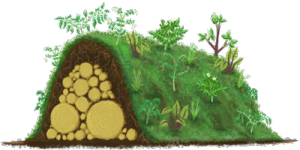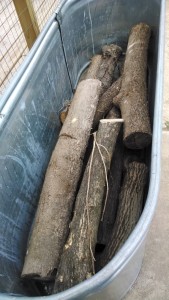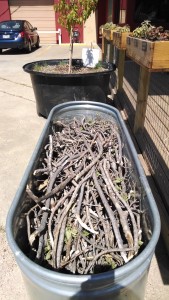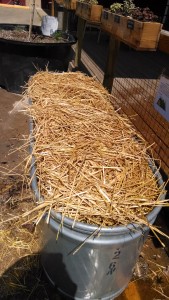In Part 1 we covered ways in which you can use compost and mulch in an existing garden bed to reduce water usage.
Now we will tackle a way to set up the garden bed to reduce water needs from the get-go!
I’ve talked about the method before – it’s called Hugelkultur, and it hails from Eastern Europe. Hugelkultur has been used for centuries, but it’s only become more popular after the publishing of Sepp Holzer’s Permaculture.
Hugelkultur works to conserve in two ways: Not only does the technique use all those trimmings from yard waste that go to the landfill, but the whole bed acts as a water sponge.
That certainly works well with water restrictions in North Texas communities and reduces water bills. I’m going to repeat what I have written before – a 100 sq. ft. bed planted in vegetables is expected to need 60 gallons of water weekly – at least.
I would love to see hugelkultur used in setting up school gardens. The reason is that school gardens are often promised water from the district for only the first year – after that, the garden manager has to devise other ways of providing water – usually rain capture. But reducing water needs is critical, whether the district pays the bill or rain is borrowed.
Basically, hugelkultur copies what we find in a forest floor – dead and rotting trees, covered with limbs that fall, then by leaves which decompose and we have a soft, cushiony bed in which all sorts of life thrives.
Here’s what happens: the logs (old or new) rot and become porous. They serve as excellent habitat for mycorrhizal fungi, which are essentially for healthy plants. AND, as the wood rots, it acts as a sponge for water.
The end result is that hugelkultur beds don’t need to be watered nearly as often. I talked to a community garden manager last year, asking about the experimental bed she had put in. She stated that in October they had built the bed, planted broccoli, cauliflower and cabbage and – when I talked with her in February – they had still not watered since the bed was planted!
Traditionally, the hugelkultur process starts with a trench in which logs are placed, then twigs, then leaves, then compost and soil on top. It can be anywhere from a foot high to several feet. It all depends on where you live, what you want to put into it, and how high you want it to go. You can even install a hugelkultur bed for ornamentals that your HOA will approve of – just start with a trench and only go as high as 12” for the mound. Many front yard plantings go that high with mulch on top.
The bed doesn’t have to be in-ground either. Hugelkultur can be built on the ground, or in a container.
One garden I built was in a horse trough – I drilled ½” drainage holes about 8” apart on the sides of the trough. Then filled with logs, sticks, and straw, and covered with a layer of compost and planted herbs.
I read online about a lady who takes muck tubs (they are the large plastic tubs with plastic rope handles often seen in barns for hauling…muck…), puts holes in the bottom and puts a short log upright in the tub. She then drills holes in the upper end of the log (to encourage water to go into the log), fills with leaves and compost and tops with soil. Then she plants. She says at the end of the season, after having reduced the water needs in her muck tub containers, her plants have grown their roots around the log. I’m going to have to try this I think this winter!
We adapted hugelkultur last month, when we built a formal keyhole garden. The home owner had trimmed crape myrtles and was about to put them out on the street for pick up. We put those trimmings in the bottom of the keyhole garden, along with leaves, cardboard, dryer lint, straw, compost and then top soil and mulch. The garden will be a compost pile with hugelkultur overtones…a mixing of two incredible water-holding, nutrient-rich planting environments.
One caveat – the garden bed will decrease in height over time, so just keep adding mulch and compost on top. And you’ll have the richest, softest, best water-holding beds imaginable.
Be creative. Use the concept and let me know how you have used this technique that mimicks the forest floor.





